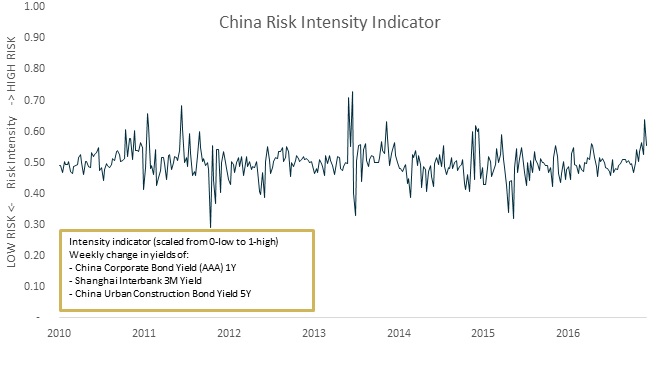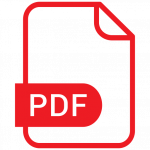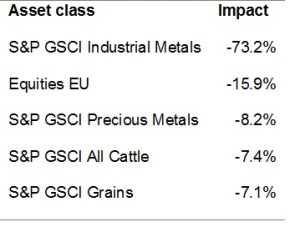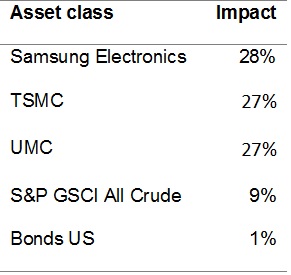Much has been discussed about the technology sector concentration of S&P 500. Although we find that the degree of concentration is not unusual, once certain myths about the largest companies are dispelled, the nature of exposure and corresponding end-market risks indicate a degree of fragility.
The concentration of the US stock market performance in the technology sector has been source for concern in the last few years. The variedly used FAAMG or FAANG acronym (alternating inclusion of either Microsoft or Netflix along with Facebook, Amazon, Apple and Google/Alphabet) has successfully taken its place next to the old favourites, such as BRICS or PIGS.
Much like the latter two sets of countries, the companies in question have more differences than commonalities and it is the underlying markets that drive the risk profile rather than the companies themselves: fortunes of Google and Microsoft are as aligned as the future performance of Brazil and India. Although there are common drivers, the specific risks are driven by underlying end-market exposures. In this issue of Risk Wire we attempt to zero in on the ultimate sources of risk with respect to the leading technology platforms, dispelling some myths on the way.
To be clear, this is not analysis of the technology sector investments in general. Rather, we attempt to evaluate the exposure of the market to the five leading companies and the underlying risks that exposure implies.
Author: linksweb
Risk Wire: Do Inflationary Concerns Warrant Hedging?
Some sources of inflationary risk are more benign than others. Given the structural headwinds that the global economy faces, a broad inflation hedging programme can be expensive and unnecessary. On the other hand, the likelihood of unexpected inflation driven by regulation or supply shocks is increasing. This points to a more targeted approach when managing inflation risk.
Continuously low interest rates in the face of very low unemployment rate justifiably raise inflationary concerns. Protecting institutional portfolios against inflation does not come cheap – sensible hedge against inflation comes with increasing volatility and adds to the risk of the portfolio. It is therefore worthwhile to consider whether at least in the typical “core” scenarios of pension funds, inflationary concerns are truly justified.
The persistent low-trending levels of inflation in the past two decades are likely to be the effect of the emergence of global value chains and automation. Although there is significant political push-back against globalisation that can in theory reverse its effect on inflation, i.e. cause domestic price increases, our estimates suggest that the disinflationary effects of automation and ageing population in the coming years more than make up for the difference. In fact, if anything, the combined effect of long-term structural trends point at ~ 90 bp lower demand-driven inflation going forward. An active inflation hedging program for demand-driven inflation is therefore likely to cost more than its potential benefit.

Run Economic and Geo-political Scenarios
Impact of New Steel and Aluminium Tariffs Imposed in the US
On February 2, 2018 the US administration announced a new set of tariffs to be applied on imports of steel and aluminium. The tariffs of 25% and 10% respectively will disproportionately affect US’ closest ally and trading partner – Canada. The other countries have relatively manageable exposure to the US imports (see the table below).
Although the event can be applied in Mira either by volume or price impact, we have elected to use the price impact as the key input. Price impact values are derived by weighting the value of exports of steel and aluminium into the US and applying respective tariffs. Only steel has been taken into account in the analysis of countries with small exports of aluminium (Brazil, South Korea, Mexico, Turkey and Japan).
| Country | % of Imports Steel |
% of Imports Aluminium |
Price Impact | US as % of Exports |
Volume Impact |
|---|---|---|---|---|---|
| Canada | 16% | 52% | 17% | 78% | 27.1% |
| Brazil | 13% | 0 | 25% | 8% | 2.8% |
| South Korea | 10% | 0 | 25% | 14% | 4.9% |
| Mexico | 9% | 0 | 25% | 27% | 9.3% |
| Russia | 9% | 16% | 19% | 16% | 5.6% |
| Turkey | 7% | 0 | 25% | 10% | 3.5% |
| Japan | 5% | 0 | 25% | 7% | 2.6% |
A more detailed breakdown of the trade patterns can be found on the MIT OEC website.
Register for Webex: Running The Tariff Stress Scenario in Mira ABM
3 pm Monday, 5 March, 2018
[contact-form-7 id=”1408″ title=”event_subscribe”]
[/one_third]
Investing in the Age of Disruption
The emerging disruptive forces of technological, political and demographic change threaten to destabilise long-term investment performance. It will take special kind of capacity building and flexibility for institutional investors to benefit from disruption rather than fall prey of it.
We live in an age of unprecedented confluence of multiple disruptions. First, there is a generation of twenty-somethings set on disrupting virtually every industry using technology that did not exist or was too expensive a few years back, some of them succeeding in the process. Then there is the macroeconomic disruption brought by ageing population, stagnant productivity. There is the political disruption of Trump, Brexit and all the rest of isolationist and populist tendencies – evidence suggests that reversal of globalisation is progressing fast. Of course, the environmental disruption is hard to ignore. These trends happen very quickly in the historical context and reinforce each other.
What is the implication for the investment policy, if any? In the first issue of the Risk Wire this year, we attempt to take stock of all these disruptive trends and draw some conclusions in terms of the appropriate policy response.
Run Economic and Geo-political Scenarios
Risk Scenarios 2018
What Could Possibly Go Wrong?
It is not easy to build plausible yet severe economic scenarios. Doubly so, if those scenarios are assessed in LINKS Mira Agent Based Model (ABM). Unlike conventional models, Mira ABM takes into account unintended consequences of events – both positive and negative. Just like in real life, positive and negative effects cancel each other out, with little impact on investments. So suggest your scenario for 2018 by describing it on our LinkedIn feed, or better still, by downloading Mira ABM and introducing the scenario in our system. The best (or the worst?) scenario will earn you a New Year’s gift and a professional reputation among our institutional clients.
Some effective scenario pointers:
-
Any social, geopolitical or economic hypothetical but plausible event can become a basis for a scenario
-
In order to build a scenario, we will need “the point of first impact”, i.e. an industry in a country that experiences direct economic hardship in terms of changes prices or volumes due to the scenario. For example, an incomplete scenario is “a war in North Korea”. A more complete scenario is: “a war in North Korea cuts production volumes of mobile phones, semiconductors and flat screens in South Korea”.
-
Impactful scenarios tend to be large, across multiple industries and countries with greater trade ties with the rest of the world.
-
You can read more about building scenarios with Mira ABM here.
How to Suggest a Scenario:
You can describe the scenario on our LinkedIn feed., or send as an email: info@linksanalytics.com
Run Economic and Geo-political Scenarios
End of Oil Greatly Exaggerated
Of all the global risk sources at the tail end of 2017, a sudden oil price shock arguably poses the greatest risk to institutional portfolios both in terms of its likelihood and the severity of impact. But perhaps the most troublesome factor is the complacency or lack of attention towards this risk; if anything, investors’ concern is over sharply lower oil prices.
The reasons for complacency could be traced to the widespread belief that the days of significance of oil as key commodity are numbered, and that we have already seen the beginning of marginalization of oil as energy source. The reality cannot be farther from the truth:
-
the world is using more oil than ever before,
-
electrification of transport will not matter at least until 2025,
-
traditional oil producers have underinvested,
-
shale oil producers face limits to productivity gains.
All of the above prompted us to carry out a 75% price hike scenario analysis using LINKS Mira ABM. Our conclusion is that the resulting environment will be toxic for fixed income instruments due to the inflationary pressure, but there will be bright spots to hedge with.
Run Economic and Geo-political Scenarios
Investment Risk: Higher Rate Drivers
Institutional investors often assume a degree of “return-to-normality” for long-term rates in their investment plans. But what are, if any, the preconditions for return to higher interest rates? And if those preconditions are not met, what could be the expectation range that takes into account the structural drivers of interest rates?
The fortunes of pension funds at least on paper depend on the level of long-term (real) interest rates. Despite new all-time highs in equity prices, pension funds are not keen to celebrate so long as the rates remain subdued and the net present value of liabilities remains high.
Our conventional “classical” understanding of business cycles suggests that there should be a positive correlation between long-term interest rates (bond yields) and equity markets: as the aggregate demand picks up, so does the long-term GDP growth rate and finally – interest rates. This understanding however falls short of explaining the secular decline in long-term interest rates observed in most of the developed markets.
Download the full report:
Risk Wire: Is Global Reflation Sustainable?
The global reflation trade has been in the centre of investor attention lately. One-off factors such as Brexit, commodity price increases due to government policy in China and oil price that rebounded from low levels, could explain much of this reflation. We audit the “trail” of reflation sources and identify a key vulnerability in the reflation narrative. We also introduce two risk scenarios in Mira ABM related to reflation: i) Disorderly Collapse of China’s Economy and ii) Collapse of Oil Price.
There is a modest global reflation unfolding in the last few quarters that has been hailed by investors and regulators as a welcome sign of economic normalisation. Should this process be sustained, it is fair to assume that the long-term interest rates will go back to their historical average values, thus putting an end to the era of financial repression.
Before getting too excited, we checked the source and sustainability of this reflation. Under normal circumstances, reflation is a reliable sign of improving economic outlook and earnings. In this issue of Risk Wire, we try to identify the sources of reflation in so far as positive earnings dynamics are concerned. We zero in on a key weakness of the reflation narrative and develop two “contrarian” scenarios for LINKS Mira ABM: “Disorderly Collapse of the Chinese Economy” and
“Oil Price Collapse”.
Run Economic and Geo-political Scenarios
Risk Wire: Quantifying the Headlines From Trump to Brexit
Is media coverage of potential sources of economic disasters proportionate to their likely impact on the economy and institutional portfolios? Investors form their perception of the magnitude of risk based on large number of public sources. Political biases, different estimation approaches and assumptions may result in unfair attention to things that do not matter and lack of attention to significant risks. We use Mira ABM to evaluate the impact of two widely covered global geopolitical risks with surprising results.
In this issue of Risk Wire we introduce two global risk scenarios:
i. Advancement of populist economic policies in the USA
ii. Hard Brexit
In contrast with our earlier work, these risk scenarios do not originate in our frameworks. Instead, we opted for collecting key generic global risks that attract the most attention in the investment community. We introduced these risks in Mira ABM* and found that despite their headline-grabbing nature, geopolitical scenarios appear to have no meaningful impact on a typical pension fund portfolio at least in the time frame of up to three years. Figure 1 represents a comparison of these two scenarios with two economically-driven scenarios covered by LINKS.
Run Economic and Geo-political Scenarios
Risk Scenario: China Disorderly Economic Collapse
Why is The Scenario Risky?
The second largest economy in the world, with reported debt-to-GDP rate of 240% to 280% and a far greater ratio, if shadow banking is taken into account (source: Bloomberg, World Bank), must be a source for concern. More worryingly, the pace of debt build-up is among the fastest in the world: average annual credit growth rate of 20% between 2009 and 2015 was accompanies by GDP growth rate of only 6-7%. “Out of 43 economies where credit-to-GDP ratio increased by more than 30 percentage points within five years, 38 economies subsequently experienced severe disruptions, manifested in financial crises, growth slowdowns, or both.” China’s credit-to-GDP ratio increased by nearly 50%. As long-term risks are too high to bear in the corporate debt market, companies are resorting to short-term funding. The average weight of debt maturing in less than 12 months in total debt among 1020 largest state-owned enterprises (SOEs) is at 66%.
Where Does the Risk Come From?
Debt is not just a result of overly ambitious growth appetite; China’s SOEs have been operating at economic losses for decades – losses that had to be financed somehow.Average Returns on Capital (ROCs) at state-owned enterprises are at 4.5 %. Real market cost of capital is a weighted average of 4-6% on wealth management product yields (the “unregulated level of return”) and cost of equity of 8-10%, i.e. the real cost of funds is near 8%. This means on a $100 investment an average Chinese SOE makes $4-6 and pays $8 as interest, generating a loss of $2-4. Increasing volumes of investment only increase the losses and debt. Only 1 out of 17 SOEs in the CSI index earns more than 8% on capital invested. Cutting investment is not an option due to the political fallback – resulting unemployment and social unrest will be difficult to handle.
The Not So Obvious
Large part of key industries’ balance sheets are supported by property and infrastructure prices. Property prices are supported by more credit. If this demand wanes, balance sheets of companies will look even worse than they are now. Balance sheets of banks are funded by the off-balance-sheet Wealth Management Products (WMPs) – investment instruments sold to clients with implicit guarantee by the bank. Money raised is then used to buy (among other investments) corporate bonds, proceeds of which are used to pay back balance-sheet debt. The mechanism moves debt off the banks’ balance sheets.
The Initial Impact
Most debt is accumulated in Local Government Finance Vehicles (LGFV’s) and SOE’s, in turn held by banks and structured in WMPs. SOE’s ability to maintain certain level of interest payment is key, which in turn depends on their profitability.Actual interest paid is a bad measure: debt is often rolled over with interest payments capitalized. Many SOEs in reality do not pay interest because they cannot afford to. To determine the industries that are likely to collapse first, we use ROC and size cut-offs. We focus on the least profitable and largest SOEs in China. The scenario assumes a decline in revenues (driven by volumes) of between 10% and 30% – proportional to ROCs and consistent with historical recessions.
The Contagion Effect
Worst impacted assets are industrial metals at over 70% downside, followed by equities in Europe at nearly 16%.
Safe Assets
Clearly, US Treasuries are a safe asset to hold in such an event; even though China holds significant reserves of US Treasuries, the demand for Treasuries in this scenario will outweigh the selling pressure from China. A more aggressive hedge against the scenario is a position in electronics and semiconductors manufacturers in Taiwan and Korea. Based on the supply chain analysis LINKS Mira indicates a strong negative relationship between the heavy industries that are part of the weak SEO scenario and advanced electronics and semiconductors: the resulting lower prices for industrial and precious metals are positive for electronics, while the Chinese and global demand for electronics will fall to a lesser extent.
Intensity
Financial risk resides in the bond market, which is observable. The intensity indicator is based on weekly change in yields of three indices representing industrial, interbank and construction markets, with a high risk intensity corresponding with 100 basis point shift in yields in a week – a significant stress in a system.
- Component 1: China Corporate AAA Bond 1Y yield
- Component 2: Shanghai Interbank 3M yield
- Component 3: China Urban Construction Bond 5Y yield
















